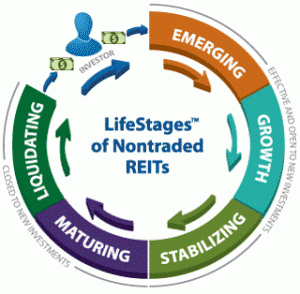Accessing Direct Lending with Interval Funds
June 4, 2019 | Luke Schmidt | Blue Vault
 While interval funds have been around for many years, their popularity did not begin to grow until more recently. The flexibility in investment options has drawn interest from investors who crave access to the alternative space but do not want to be limited to the stricter investment guidelines present in nontraded REITs and nontraded BDCs. Interval funds have the ability to invest in a diverse mix of assets, including, but not limited to, commercial property, private equity funds, business loans, bonds, and real estate securities, or a combination. Not only do investment types vary from fund to fund, but how the investments are sourced can also vary. When it comes to lending, there are several asset products utilized by credit interval funds, including commercial mortgages, bank loans, high yield bonds, and direct lending assets.
While interval funds have been around for many years, their popularity did not begin to grow until more recently. The flexibility in investment options has drawn interest from investors who crave access to the alternative space but do not want to be limited to the stricter investment guidelines present in nontraded REITs and nontraded BDCs. Interval funds have the ability to invest in a diverse mix of assets, including, but not limited to, commercial property, private equity funds, business loans, bonds, and real estate securities, or a combination. Not only do investment types vary from fund to fund, but how the investments are sourced can also vary. When it comes to lending, there are several asset products utilized by credit interval funds, including commercial mortgages, bank loans, high yield bonds, and direct lending assets.
“Direct lending” is a term meant to describe a transaction where a lending source directly provides a loan to the borrower without the use of an intermediary. This is accomplished by going directly to private equity sponsors or owner/operators of middle market companies, commercial projects, or commercial real estate to originate loans. Direct lending is beginning to emerge as an attractive asset class among institutional investors. It can generate risk-adjusted returns with high current income and lower volatility compared to other similar fixed income alternatives. Investors find middle market direct loans attractive due to their floating rate nature, high current yields, and lack of correlation to traded assets. Additionally, due to stronger covenant packages and more frequent and transparent financial reporting, these loans provide greater risk mitigation compared to broadly syndicated transactions.
The market opportunity for direct lending has evolved over the past several decades as commercial banks have reduced their appetite for originating and holding large amounts of leveraged loans to middle market companies. This shift in bank behavior was driven by significant consolidation, increased regulation, and lack of infrastructure. As a result, banks have ceded market share to a growing number of non-bank, direct lending platforms who have filled the void in the marketplace.
Debt products commonly used in the direct lending market include the following:
•First Lien loans place a first priority, perfected lien against substantially all assets of a business. In other words, if a loan goes into default, the lender is the first party to be repaid with the proceeds from the liquidation of the assets.
•Second Lien loans are second in priority to the collateral of a company’s assets. Even though this loan is secured, it is junior to the first lien loans, meaning the lender gets repaid only after the first lien lender is fully repaid.
•Unitranche loans combine a senior and junior credit position into one blended loan, providing the borrower with a simplified “one stop” source of financing, as opposed to working with two lenders, which brings about syndication risk.
•Subordinated/Mezzanine financing is debt that is subordinated to all other liens as it is unsecured. This includes first lien, second lien, and unitranche loans. It does, however, have a priority claim to equity upon liquidation or restructuring of the business.
Middle market loans in the direct lending space come primarily from one of three primary origination channels:
•The Sponsored Channel is the most common and advantageous to lenders, allowing them to benefit by investing alongside control-oriented financial sponsors that take an active role in managing their portfolio companies, have particular insight into industry trends, and will typically support their investments with additional equity capital, if needed.
•Non-Sponsored or Direct to Company transactions require constant communication with management teams and tend to require a more significant involvement from the lender during both the due diligence phase and portfolio monitoring. These are typically smaller and more labor-intensive but can generate more attractive risk-adjusted returns.
•The Capital Markets channel involves participation from a third-party distributed investment. These are typically priced more efficiently, with the main drawback coming from the fact that these transactions are intermediated, meaning the terms have already been negotiated.
The structural changes that have led to the emergence of direct lending over the past several decades are the same changes that will lead to its continued growth if/when the credit cycle turns. Equity cushions and seniority in the capital structure make direct lending less vulnerable to economic cycles compared to equity. Additionally, direct lending provides less volatility compared to other liquid credit assets, giving lenders and shareholders some peace of mind.
One of the primary benefits of interval funds includes the periodic share repurchase offers made to shareholders, with a typical fund repurchasing 5% of outstanding shares every three months. The interval fund structure allows for a much larger pool of illiquid investments with less concern about daily liquidity, as is an issue with open-end funds that have daily redemptions. By investing in less liquid assets, firms are betting on themselves that they will be able to generate greater returns compared to those funds that are offering daily liquidity. A direct lending interval fund is able to strategically allocate its funds to invest in illiquid assets with the intent of pushing up returns while still meeting its quarterly redemption requests.
In 2017, CION Investment Group (“CION”) formed a partnership with Ares Management, L.P. (NYSE: “ARES”), a publicly traded, leading global alternative asset manager with approximately $137 billion in assets under management. The result of this partnership was the creation of a globally diversified interval fund. When it comes to direct lending, ARES is one of the biggest direct lenders in the world with over $66 billion in assets under management.
To learn more about CION Ares Management and their interval fund, head to www.cioninvestments.com
Sources: Blue Vault, SEC, Interview with Mark Gatto, Ares Direct Lending Whitepaper











